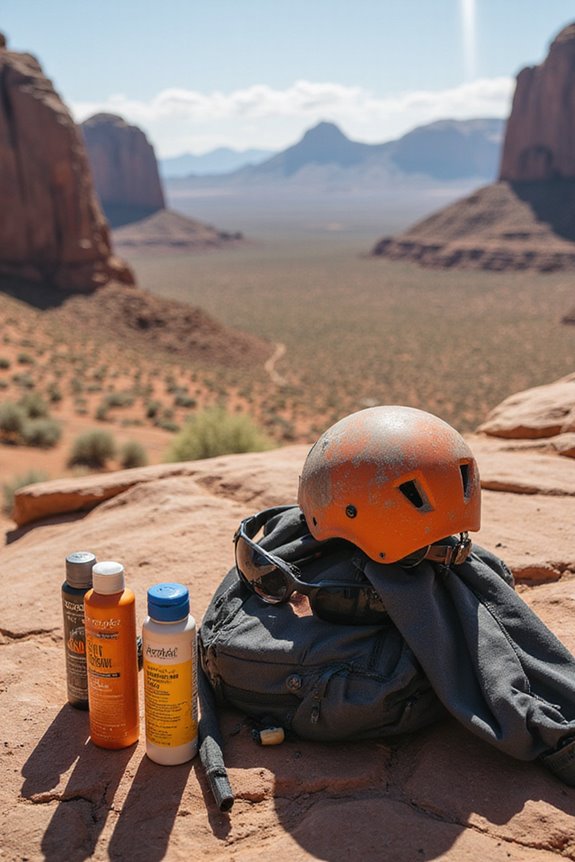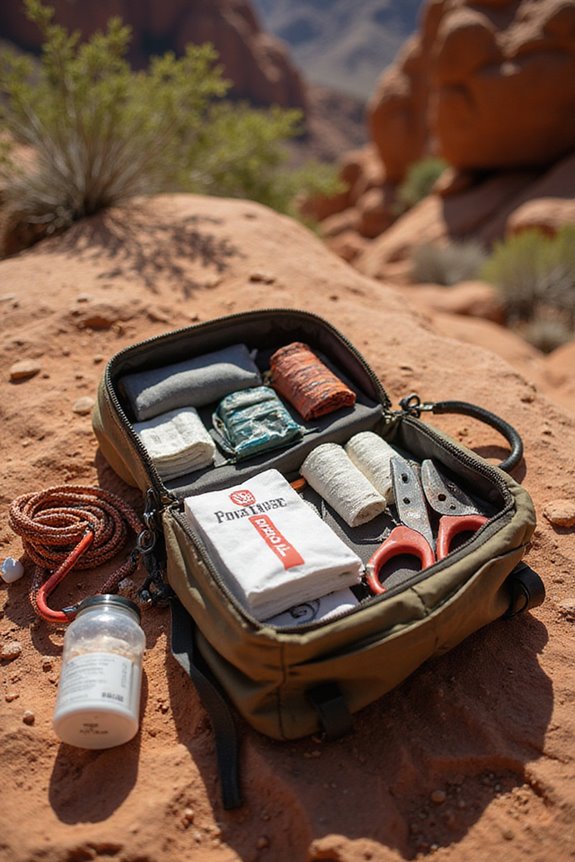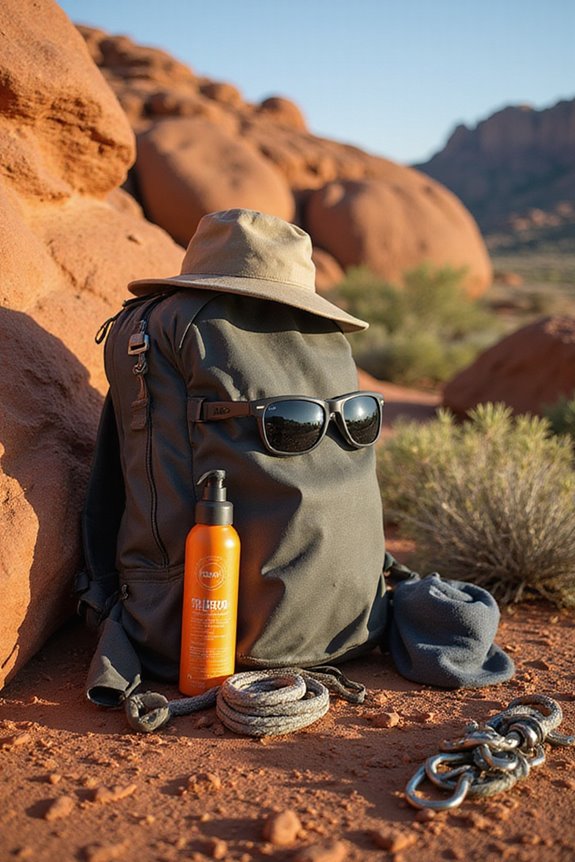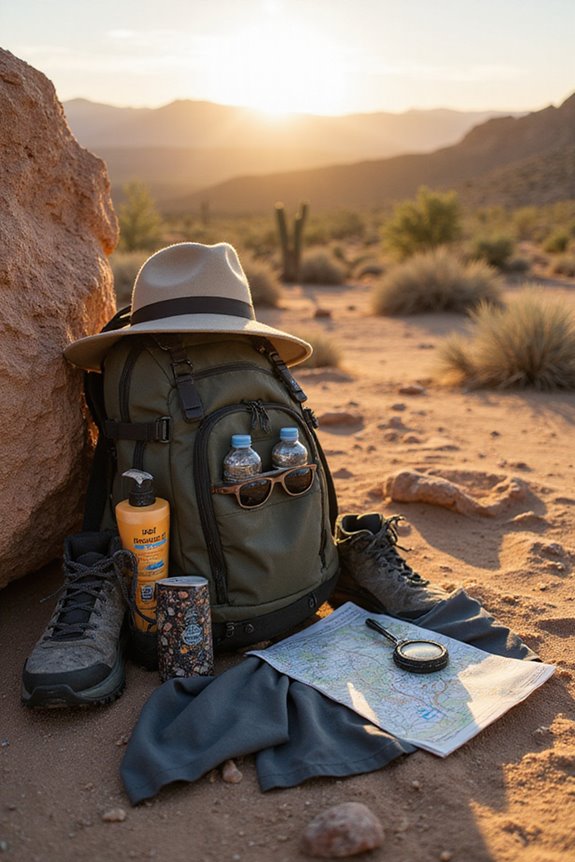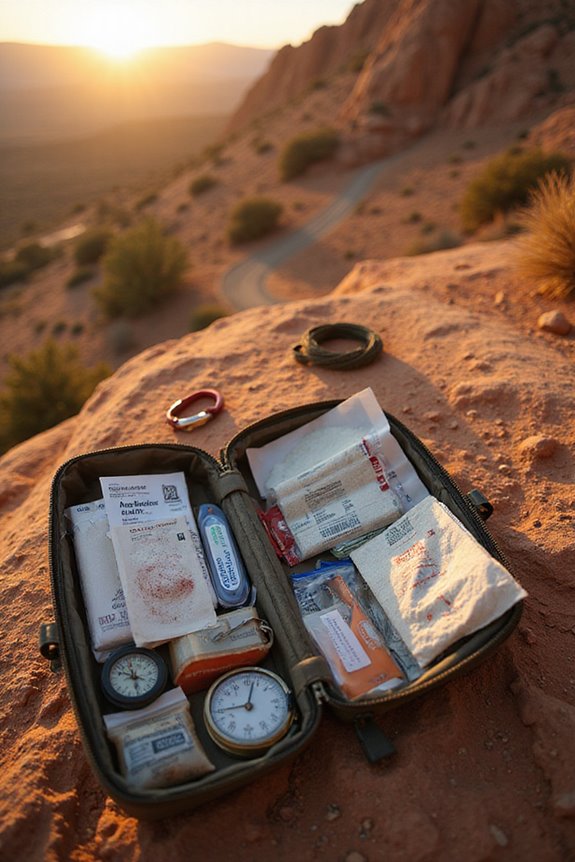Choosing sun protection is essential for our outdoor adventures! First, we need broad-spectrum sunscreen with at least SPF 30—think of it as our trusty shield against harmful rays. Don’t forget to take into account our skin type: fair folks should aim high with SPF 50, while those with medium or dark skin can stick to SPF 15-30. And remember, a fun hike isn’t complete without wide-brimmed hats and UV-blocking clothes! Stick around and we’ll explore more sun-savvy tips!
Key Takeaways
- Select a sunscreen with broad-spectrum protection, ensuring it blocks both UVA and UVB rays for optimal safety.
- Choose an SPF of 30 or higher for adequate protection, especially for outdoor activities and beach days.
- Look for water-resistant formulas to maintain efficacy while sweating or swimming.
- Consider your skin type; lighter skin typically needs higher SPF, while darker skin should at least use SPF 15.
- Always check expiration dates and apply generously about 15-30 minutes before sun exposure for effective coverage.
Understanding SPF and Its Importance
When we’re out on the trails, soaking up the sun can feel incredible, but it also means we’ve got to get serious about sun protection! We often encounter SPF myths, thinking that higher numbers mean we can party in the sun all day without a care. But here’s the deal: while SPF measures UVB protection, it doesn’t mean we’re invincible against sunburn or skin damage from UVA rays. We should all get savvy with SPF education to pick the right protection for our unique adventures. Trust me, if we’re hiking in the blazing sun, a solid SPF 30 or higher should be our go-to. For optimal protection on the trails, consider wide-brimmed hats with UPF 50+ rating which blocks 98% of harmful UV rays. Let’s keep our skin healthy so we can enjoy countless trails without a sunburn ruining our outdoor freedom!
The Need for Broad-Spectrum Protection
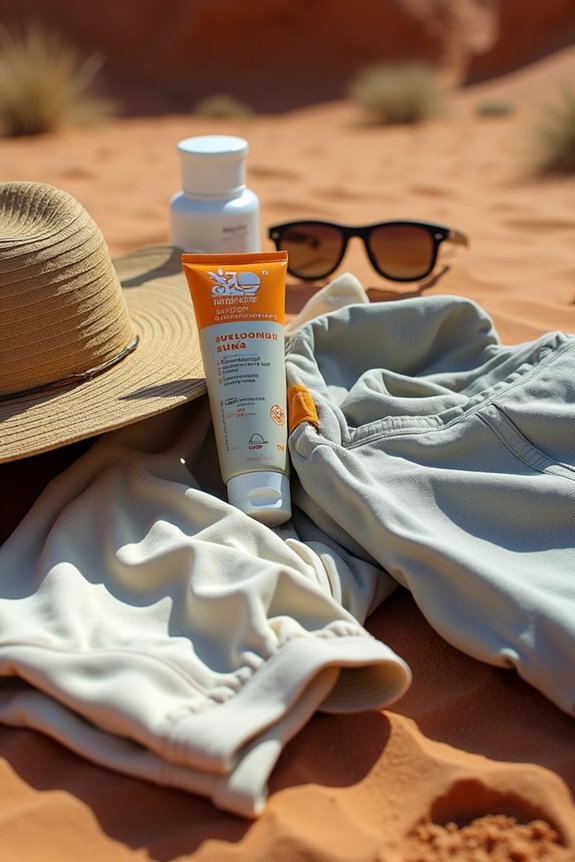
As we hit the trails, it’s not just our muscles that need protection; our skin deserves the same care! That’s why we can’t overlook broad-spectrum sunscreens. Trust me, the broad spectrum benefits are essential. While UVB rays might give us those painful sunburns, it’s the sneaky UVA rays that stealthily age our skin and increase skin cancer risks. We want to feel that freedom outdoors without the worry of premature wrinkles or skin damage! Make sure your sunscreen states “broad-spectrum”—it’s our shield against the full spectrum of UV radiation effects. Wide-brim hats with UPF 50+ ratings provide an additional essential layer of protection against harmful sun rays. So, grab that bottle, slather it on, and let’s embrace the sun safely while soaking in all that nature has to offer. Adventure awaits!
Recommended SPF Levels for Different Skin Types
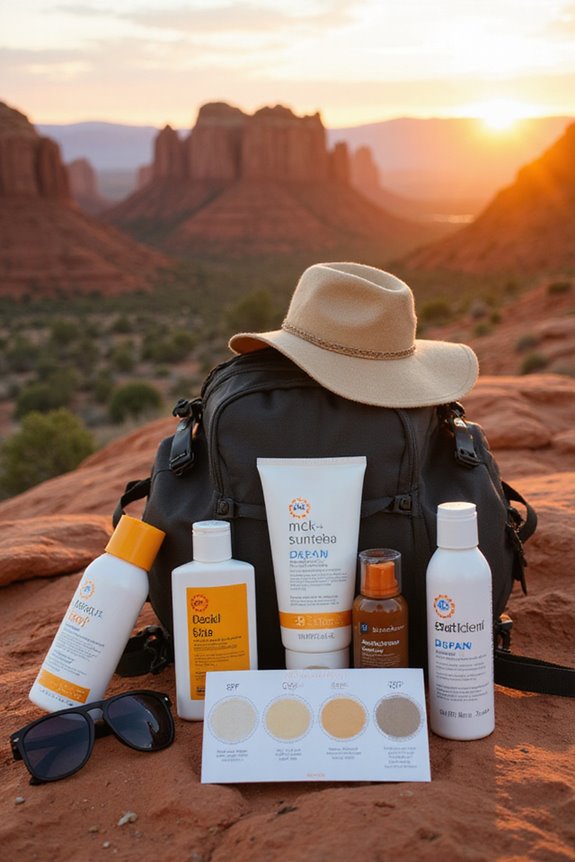
Choosing the right SPF level for our skin type is essential before we venture out into the sunshine. For those of us with fair skin, we need at least SPF 30, or even SPF 50+ if we’re planning a beach day! Medium skin types can enjoy SPF 15 to 30 for daily wear, but let’s not shy away from SPF 50 during those epic outdoor adventures. Dark-skinned friends, don’t think you’re off the hook—SPF 15 is the minimum, though 20 to 25 offers extra security against sneaky UV rays! And if we’ve got sensitive skin, let’s stick with gentle mineral sunscreens and opt for SPF 30-50+. Just like waterproof hiking jackets provide protection from rain, proper sunscreen shields us from harmful UV radiation. Remember, skin protection is our key to freedom in the sun! Let’s embrace the shine, safely!
Sun Protection Behaviors Beyond Sunscreen
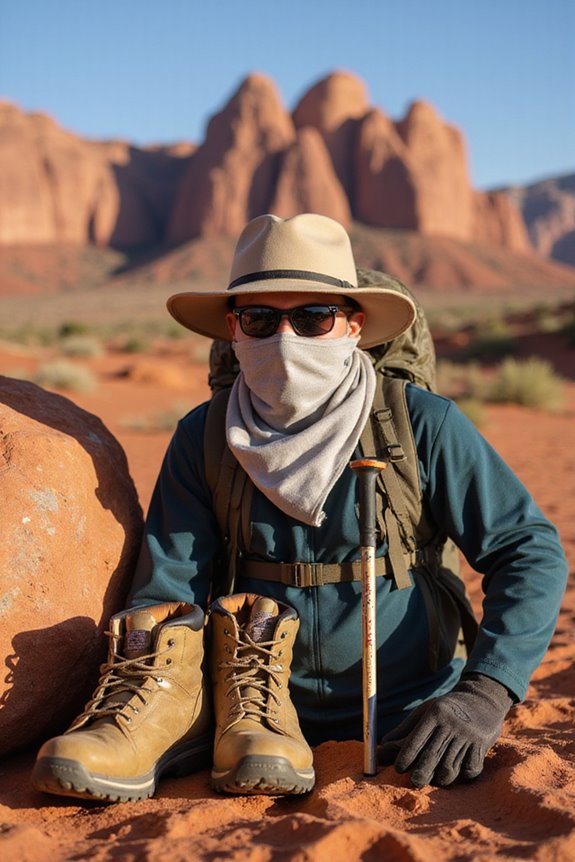
While sunscreen is a must-have for sun protection, it’s just the tip of the iceberg when it comes to fully safeguarding ourselves from those sneaky UV rays! Let’s embrace clever behavioral strategies—like seeking shade and planning our outdoor adventures in the early morning or late afternoon. We can wear UPF-rated clothing and stylish wide-brimmed hats to keep our skin protected. And let’s not forget about dietary supplementation! Boosting our antioxidant intake with vitamins C and E can give our skin some extra love. Remember, these steps aren’t just good ideas; they’re essentials for living freely under the sun without fear. So, let’s gear up and tackle those trails while keeping ourselves safe and healthy! Look for shirts with UPF 50+ rating, which blocks about 98% of UV rays, offering effective protection against harmful UVA and UVB radiation.
Application Techniques for Maximum Efficacy
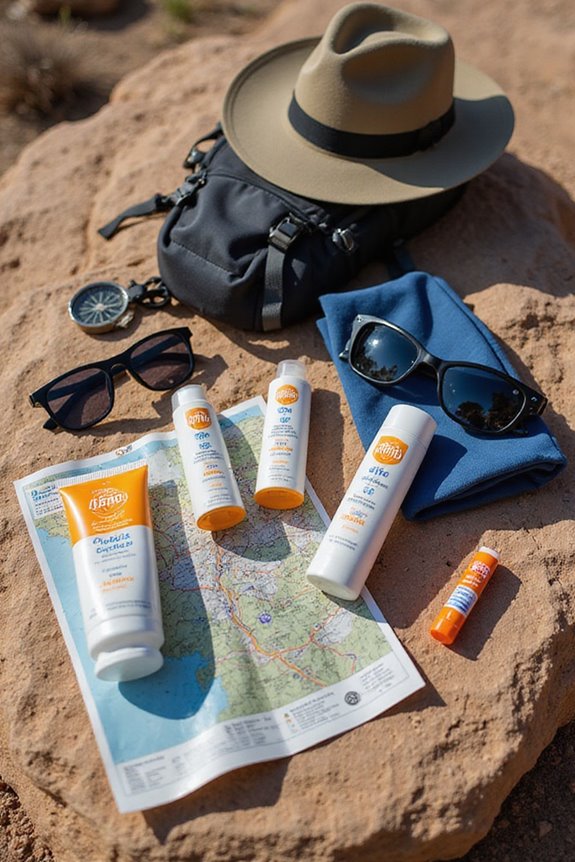
Ready to maximize our sun protection game? Let’s plunge into some simple but effective sunscreen application techniques! We should aim to apply 1 ounce—think golf ball size—for each exposed area, ensuring even coverage. Trust us, missing spots like the tops of our ears or back of our hands can lead to painful burns.
Effective layering’s our best friend here; applying sunscreen twice—first before heading out and again shortly after—really amps up protection. Remember, applying it 15-20 minutes before we hit the sun allows it to set properly, creating that essential barrier against those pesky rays. For rainy weather excursions, consider adding a waterproof nylon jacket for comprehensive protection against harmful UV rays that penetrate cloud cover. Whether we’re hiking trails or chilling at the beach, we can enjoy our freedom while keeping our skin happy and healthy!
Reapplication Guidelines for Extended Protection
How often should we be slapping on that sunscreen? The general rule is every two hours, but let’s not kid ourselves. If we’re sweating buckets or splashing in the waves, we need to reapply immediately! That beautiful sunny day can turn into a sunburn nightmare if we don’t hustle.
During peak sun exposure hours, say 10 AM to 4 PM, we might even want to reapply every 40 to 80 minutes—trust me, it’s worth it! Light activities can strip away our protection just like heavy-duty hiking. Remember, no sunscreen is one-hundred percent waterproof, so let’s keep that magic bottle handy. Let’s stay safe out there and enjoy the freedom of the great outdoors, one sunblock slather at a time!
Choosing Sunscreen Based on Skin Type and Conditions
Ever wondered which sunscreen is best suited for your unique skin type? Let’s explore! For those of us with dry skin, creamy formulations with hydrating ingredients like hyaluronic acid make a world of difference. If your skin’s oily or combination, lightweight gel or mattifying sunscreens are your go-tos. Got skin sensitivities? We should totally opt for fragrance-free and hypoallergenic options to keep irritation at bay. And for our acne-prone friends, a non-comedogenic, oil-free sunscreen is essential. Remember, mineral sunscreens, like those with zinc oxide, are often gentler on sensitive skin. Let’s stay safe while we soak up the sun—because nothing ruins a great day outdoors like a rash! Happy trails, sun lovers!
The Role of Protective Clothing and Shade
When we hit the trails, one of our best allies against the sun isn’t just sunscreen—it’s protective clothing and a little savvy about shade! Let’s talk about how those nifty UPF fabrics keep us safe. Higher UPF ratings mean better protection, so going for 30 or 50+ can save our skin from nasty sunburns. Trust us; it’s easier than constantly slathering sunscreen everywhere!
And don’t overlook shade structures. Trees, canopies, or those epic picnic tents can be lifesavers during peak sun hours. We get to enjoy the outdoors while lowering our UV exposure—how great is that? So, let’s rock those long sleeves and wide-brimmed hats, and embrace the magic of shade while we explore!
Consulting Professionals for Personalized Recommendations
While we love the thrill of exploring new trails under the sun, there’s no denying that personalized recommendations from a professional can turn our outdoor adventures up a notch! Nothing beats that feeling when an expert assesses our unique skin types and helps us choose the right sunscreen. With a personalized consultation, we get tailored tips that suit our lifestyle and location. They can pinpoint high-risk factors and recommend effective SPF levels to keep us protected without a greasy feel. Plus, regular visits guarantee we catch any skin changes early. So, let’s connect with a dermatologist and gear up for sun-sational adventures—because safeguarding our skin is as thrilling as conquering the next summit!
Frequently Asked Questions
Can I Use Last Year’s Sunscreen?
We can use last year’s sunscreen if it’s stored properly and shows no expiration indicators like changes in smell or consistency. However, if uncertain, we should replace it for the best protection and peace of mind.
Are Chemical Sunscreens Safer Than Physical Sunscreens?
Like Odysseus traversing treacherous seas, we question: are chemical sunscreens safer than physical ones? While chemical ingredients may cause skin sensitivity for some, we often find physical options gentler and more protective, steering clear of irritation.
How Do I Know if My Sunscreen Is Expired?
To know if our sunscreen’s expired, let’s check the labels for expiration dates. If it smells off, has odd textures, or changed color, it’s best we replace it and embrace the sun safely!
Can I Use Makeup With SPF Instead of Sunscreen?
We can’t rely solely on makeup with SPF for sun protection. Makeup effectiveness varies, and SPF ratings often underestimate real-life application. Combining quality sunscreen beneath our makeup is essential for ideal skin defense and freedom from sun damage.
Does My Car’s Windows Block UV Rays Completely?
Just like a cracked umbrella in a downpour, our car windows don’t block UV rays completely. However, window tinting benefits enhance UV protection efficiency, ensuring we enjoy freedom from sun damage while driving.

